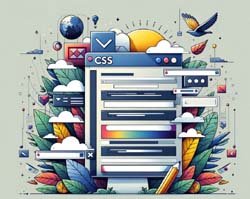CSS (Cascading Style Sheets) is a fundamental technology for web development, responsible for defining the presentation and layout of HTML documents. Its uniqueness lies in several key aspects that empower developers to create visually appealing and user-friendly websites efficiently.
Firstly, CSS enables separation of concerns by decoupling content (HTML) from its presentation (styling). This separation enhances maintainability and allows for easier updates and modifications without altering the underlying content structure.
Secondly, CSS offers flexibility in styling. Developers can apply styles globally across a website or target specific elements with precision using selectors. This flexibility extends to responsive design, where CSS media queries adapt layouts to different screen sizes, ensuring a consistent user experience across devices.
Moreover, CSS supports modularity through techniques like classes and reusable stylesheets (CSS frameworks). This modular approach promotes code reusability, consistency in design, and scalability as projects grow in complexity.
Another standout feature of CSS is its ability to create visually rich interfaces. Beyond basic styling (fonts, colors, margins), CSS3 introduced advanced features such as animations, transitions, gradients, shadows, and flexible box layouts (Flexbox) and grid-based layouts (CSS Grid). These capabilities empower developers to craft engaging user interfaces and immersive web experiences.
Furthermore, CSS contributes to accessibility by allowing developers to enhance readability, ensure contrast for readability, and optimize layouts for screen readers and other assistive technologies. Accessibility-focused CSS practices are crucial for inclusive design, ensuring that websites are usable by people with diverse abilities.
CSS also plays a pivotal role in performance optimization. By reducing page load times through efficient CSS code (minification, optimization), developers can enhance user experience and positively impact SEO (Search Engine Optimization).
The evolution of CSS has been marked by continuous improvements and standards adherence, driven by community feedback and browser advancements. CSS preprocessors (e.g., Sass, Less) and postprocessors (e.g., Autoprefixer) have further expanded CSS capabilities, introducing variables, mixins, and automatic vendor prefixing to streamline development workflows.
In terms of cross-browser compatibility, CSS standards ensure consistency in rendering across various browsers and devices. Browser developer tools provide invaluable resources for debugging and optimizing CSS, enhancing compatibility and performance.
CSS is integral to modern web development frameworks (e.g., Bootstrap, Tailwind CSS) that offer pre-built components and utility classes, accelerating development while maintaining flexibility for custom styling.
Lastly, CSS fosters creativity and design innovation by enabling designers and developers to experiment with new layouts, typography, animations, and visual effects. This creative freedom is essential for crafting distinctive and memorable web experiences that align with brand identity and user expectations.
In conclusion, CSS’s uniqueness lies in its foundational role in web development, enabling separation of concerns, flexibility in styling, modularity, creation of visually rich interfaces, accessibility enhancements, performance optimization, adherence to standards, cross-browser compatibility, support for frameworks, and fostering creativity. These qualities collectively make CSS an indispensable tool for crafting modern, responsive, and engaging websites.
